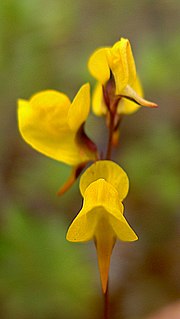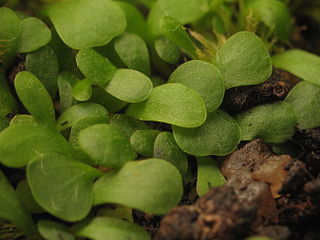Utricularia raynalii is a small, annual, suspended aquatic carnivorous plant that belongs to the genus Utricularia. U. raynalii is endemic to tropical Africa and can be found in Burkina Faso, Cameroon, the Central African Republic, Chad, Rwanda, Senegal, and Sudan. It was described by Peter Taylor in 1986 and was named in honor of Jean Raynal of the Paris Herbarium who had collected this species in Cameroon and Rwanda.
Utricularia reflexa is a small to medium-sized suspended aquatic carnivorous plant that belongs to the genus Utricularia. U. reflexa is endemic to Africa and can be found in Benin, Burkina Faso, Burundi, Cameroon, Chad, the Central African Republic, Côte d'Ivoire, the Democratic Republic of the Congo, Gambia, Ghana, Guinea, Kenya, Madagascar, Malawi, Mali, Niger, Nigeria, Senegal, Sierra Leone, Sudan, Tanzania, Togo, Uganda, Zambia, and Zimbabwe.
Utricularia appendiculata is a medium-sized, probably perennial, terrestrial carnivorous plant that belongs to the genus Utricularia and is the only member of Utricularia sect. Oliveria. U. appendiculata is endemic to Africa, where it can be found in Burundi, Cameroon, the Central African Republic, the Democratic Republic of the Congo, Gabon, Madagascar, Malawi, Mozambique, Tanzania, Uganda, and Zimbabwe. It grows as a terrestrial plant in wet Sphagnum bogs, damp sandy savannas, or in peaty marshes at altitudes from 1,500 m (4,921 ft) to 1,860 m (6,102 ft), but as low as 700 m (2,297 ft) in the Central African Republic. It flowers mostly in the wet season. It was originally published and described by Eileen Adelaide Bruce in 1933 and was placed in its own section, Oliveria, in 1986 by Peter Taylor.

Utricularia juncea, the southern bladderwort, is a small to medium sized, probably perennial carnivorous plant that belongs to the genus Utricularia. U. juncea is native to Central, South, and North America. It grows as a terrestrial plant in marshes, swamps, and pools in shallow waters, mostly at lower altitudes. It was originally described and published by Martin Vahl in 1804.
Utricularia bracteata is a medium-sized, probably perennial carnivorous plant that belongs to the genus Utricularia. U. bracteata is endemic to southern tropical Africa, where it has only been found at the type location in Angola, two other collections also in Angola, a collection in northern Zambia, and another from the Democratic Republic of the Congo. It grows as a terrestrial plant in peaty grasslands at altitudes from 1,000 m (3,281 ft) to 1,500 m (4,921 ft). It was originally described and published by Ronald D'Oyley Good in 1924.

Utricularia arenaria is a small annual carnivorous plant that belongs to the genus Utricularia. It is native to tropical and southern Africa, where it can be found in Angola, Burundi, Cameroon, Côte d'Ivoire, the Democratic Republic of the Congo, Ethiopia, Gabon, Ghana, Kenya, Madagascar, Malawi, Mali, Mozambique, Nigeria, Senegal, Sierra Leone, South Africa, Sudan, Tanzania, Togo, Uganda, Zambia, and Zimbabwe. There has also been a single collection from central India in Madhya Pradesh. U. arenaria grows as a terrestrial plant in damp, sandy or peaty soils in swampy grasslands or marshes at altitudes from near sea level to 2,400 m (7,874 ft). It was originally described and published by Alphonse Pyrame de Candolle in 1844.

Utricularia bisquamata is a small annual carnivorous plant that belongs to the genus Utricularia. It is native to southern Africa, where it can be found in Angola, Lesotho, Madagascar, Namibia, and South Africa. U. bisquamata grows as a terrestrial plant in damp, sandy or peaty soils among mosses by streams or wet depressions at altitudes from near sea level to 1,200 m (3,937 ft) in South Africa and up to 2,250 m (7,382 ft) in Angola. It was originally described and published by Franz Paula von Schrank in 1824.
Utricularia firmula is a small annual carnivorous plant that belongs to the genus Utricularia. It is native to tropical and southern Africa, where it can be found in Angola, Cameroon, Côte d'Ivoire, the Democratic Republic of the Congo, Ghana, Guinea, Guinea-Bissau, Kenya, Liberia, Madagascar, Malawi, Mali, Mozambique, Nigeria, Senegal, Sierra Leone, South Africa, Sudan, Tanzania, The Gambia, Togo, Uganda, Zambia, and Zimbabwe. U. firmula grows as a terrestrial plant in damp, sandy or peaty soils in grasslands or on wet, mossy rocks, often as a weed in rice fields at altitudes from near sea level to 2,100 m (6,890 ft). It typically flowers toward the end of the wet season. It was originally named by Friedrich Welwitsch but formally described and published by Daniel Oliver in 1865.

Utricularia livida, the leaden bladderwort, is a species of flowering plant in the bladderwort family, native to central and southern Africa, and Mexico. Growing to 50 cm (20 in) tall and broad, it is a carnivorous perennial. It was originally described and published by Ernst Heinrich Friedrich Meyer in 1837.
Utricularia pentadactyla is a small annual carnivorous plant that belongs to the genus Utricularia. It is native to tropical Africa, where it can be found in Angola, Burundi, the Democratic Republic of the Congo, Ethiopia, Kenya, Malawi, Sudan, Tanzania, Uganda, Zambia, and Zimbabwe. U. pentadactyla grows as a terrestrial plant in damp, sandy or peaty soils in grasslands or shallow soils over rock at altitudes from 1,500 m (4,921 ft) to 2,100 m (6,890 ft). It was originally described and published by Peter Taylor in 1954, the first Utricularia species described by Taylor.
Utricularia welwitschii is a small to medium-sized, probably perennial, carnivorous plant that belongs to the genus Utricularia. It is endemic to tropical Africa, where it can be found in the Democratic Republic of the Congo, Madagascar, Malawi, South Africa, Tanzania, Zambia, and Zimbabwe. U. welwitschii grows as a terrestrial plant in sandy or peaty soils in marshy grasslands at altitudes from 1,000 m (3,281 ft) to 2,200 m (7,218 ft). It was originally described and published by Daniel Oliver in 1865. Taylor previously described two varieties of U. welwitschii, U. welwitschii var. odontosepala and U. welwitschii var. microcalyx, in 1964, but later elevated them to the rank of species as U. odontosepala and U. microcalyx, respectively. It is named in honor of Friedrich Welwitsch.
Utricularia andongensis is a small, probably perennial, carnivorous plant that belongs to the genus Utricularia. It is endemic to tropical Africa, where it can be found in Angola, Cameroon, the Central African Republic, the Democratic Republic of the Congo, Gabon, Guinea, Liberia, Nigeria, Sierra Leone, Sudan, Tanzania, Togo, Uganda, and Zambia. U. andongensis grows as a terrestrial or lithophytic plant on wet, bare rocks or among mosses in grasslands at altitudes from 240 m (787 ft) to 1,800 m (5,906 ft). It was originally named by Friedrich Welwitsch but formally described and published by William Philip Hiern in 1900.
Utricularia foveolata is a small, probably annual, carnivorous plant that belongs to the genus Utricularia. It is native to the Old World tropics, where it can be found in Africa, Asia, Australia, and on the eastern end of Java. U. foveolata grows as a terrestrial or subaquatic plant in wet soils or in shallow water, sometimes as a weed in rice fields in Asia. It was originally described and published by Michael Pakenham Edgeworth in 1847.
Utricularia macrocheilos is a small annual carnivorous plant that belongs to the genus Utricularia. It is endemic to western tropical Africa, where it is only known from the mountain ranges of Guinea and Sierra Leone. U. macrocheilos grows as a terrestrial plant among wet rocks at medium altitudes. It flowers between August and January. A specimen of U. macrocheilos was originally included in the description of U. prehensilis by François Pellegrin in 1914 and also in John Hutchinson and Nicol Alexander Dalzell's 1931 description of U. micropetala. Peter Taylor recognized these specimens as a different taxon in a 1963 review of African species and treated it as a variety of U. micropetala. After further discussions with other botanists and review of the specimens, he elevated the variety to the species level in 1986 as U. macrocheilos. Compared to U. micropetala, U. macrocheilos has much longer corolla lips and less acute fruiting calyx lobe apices. Taylor notes, however, that the vegetative body of the plants and the seeds appear to be identical.
Utricularia micropetala is a small annual carnivorous plant that belongs to the genus Utricularia. It is endemic to western tropical Africa and is found in the Central African Republic, Guinea, Nigeria, and Sierra Leone. U. micropetala grows as a terrestrial plant among wet rocks at altitudes up to 1,500 m (4,921 ft). It was originally described by James Edward Smith in 1819. It can be distinguished from all other species in section Oligocista by the large and inflated spur and very short lower corolla lip.

Utricularia scandens is a small, probably annual carnivorous plant that belongs to the genus Utricularia. It has a wide native distribution that includes Africa and Asia. U. scandens grows as a terrestrial plant in wet grasslands and bogs at lower altitudes around sea level up to 2,300 m (7,546 ft). It was originally described by Ludwig Benjamin in 1847. There is a significant amount of synonymy established for this species, in part because of its large distribution and variable morphology.
Utricularia spiralis is a medium to large-sized, probably perennial carnivorous plant that belongs to the genus Utricularia. It is endemic to tropical Africa and can be found in Angola, Burundi, Chad, Côte d'Ivoire, the Democratic Republic of the Congo, Gabon, Guinea, Liberia, Malawi, Sierra Leone, Tanzania, and Zambia. U. spiralis grows as a terrestrial plant in swamps or marshes in peaty or sandy soils at altitudes from sea level to 1,860 m (6,102 ft). It was originally described by James Edward Smith in 1819.
Utricularia tortilis is a small to medium-sized annual carnivorous plant that belongs to the genus Utricularia. It is endemic to tropical Africa and can be found in Angola, Botswana, Burundi, the Central African Republic, Côte d'Ivoire, the Democratic Republic of the Congo, Ghana, Guinea, Guinea-Bissau, Kenya, Liberia, Mali, Nigeria, the Republic of the Congo, Senegal, Sierra Leone, Tanzania, Togo, Uganda, Zambia, and Zimbabwe. U. tortilis grows as a terrestrial plant in swamps or marshes in peaty or sandy soils at altitudes from sea level to 1,860 m (6,102 ft). It was originally described by Friedrich Welwitsch but validly published by Daniel Oliver in 1865.
Maltebrunia is a genus of African plants in the grass family.




